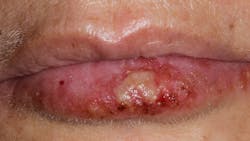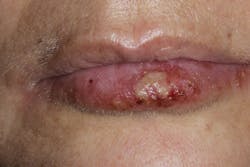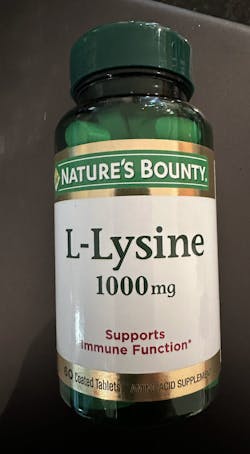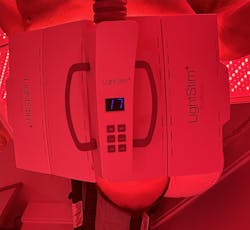Cold sore treatment: 4 methods to improve healing
Cold sores, or herpes labialis, are also known as “sun blisters”—a common viral infection of the lips or mouth area caused by the herpes simplex virus (HSV). The sores typically appear as one or more small, painful blisters or lesions on or around the lips (figure 1). Symptoms may include ulcerations, itching, burning, tingling around the mouth, and swollen lymph nodes.
Cold sores do not have a cure, and treatment usually involves antiviral drugs such as acyclovir, penciclovir, and valacyclovir in cream or tablet form. These treatments work to slow or inhibit viral replication via the herpesvirus DNA polymerase, but do not completely eliminate the virus or its recurrence.1 Side effects of these antiviral drugs taken orally include lethargy, fatigue, loss of appetite, joint pain, muscle pain, sinus congestion, and cramps.2 Currently, four different kinds of alternative treatments that can be used as stand-alone or adjunctive treatment to conventional medications have been proposed to reduce both onset and duration of the cold sore lesions.
No. 1: Lysine
Lysine is an essential amino acid (your body doesn’t make it naturally but derives it from food sources) that blocks the production of another amino acid called arginine. Lysine can be taken orally in tablet (figure 2) or powder form or can be added to an IV vitamin bag. HSV needs arginine to replicate and taking lysine prior to or during an outbreak can either prevent onset or expedite lesion resolution.
A six-month, double-blind, multicenter experiment using oral L-Lysine monohydrochloride showed that the lysine treatment group averaged 2.4 times fewer HSV outbreaks, with significantly diminished symptoms and shorter healing times (during the research period) than the placebo group.3 Another study of 1,543 patients with active cold sore lesions found that 85% of subjects who took 1,000 mg of oral lysine said their lesions healed in five days, compared to 90% reporting lesions taking six to 15 days to heal when they did not take lysine.4
Although there is no standard dosage for HSV treatment, oral dosages are suggested to be in the range of 500–1,000 mg for prophylaxis and 3,000 mg (up to 6,000 mg) during active cold sore outbreak.5 Bottom line, when compared to the established antiviral treatment, acyclovir, lysine is a safe natural compound without reported adverse side effects and is a promising alternative treatment option for patients with HSV.
No. 2: Propolis
Propolis is a resin-like material made by bees with antiviral, anti-inflammatory, antibacterial, antioxidant, and antifungal properties.6 Raw propolis comprises approximately 50% resins, 30% beeswax and fatty acids, 10% essential oils, 5% pollen, and 5% of various organic compounds such as vitamins, minerals, and sugars. The most important complex chemical compound that renders propolis an antiviral agent is phenolic acid, which can negatively affect HSV-1 and HSV-2 viral replication in host cells.7
A recent randomized, double-blind, placebo-controlled clinical trial to assess the efficacy of 3% propolis ointment (Herstat) in patients with a history of HSV-1 infection showed a mean healing time of 6.24 days, compared to 9.77 days in the placebo group, along with better pain relief. Of the surveyed propolis ointment group, 81.8% judged their treatment to be “very effective” compared to 60% of the placebo group finding the ointment “hardly effective.”8
Utilizing propolis in conjunction with acyclovir has been shown to synergistically suppress HSV-1/-2 recurrence over acyclovir alone.9
No. 3: Low-level laser therapy
Low-level laser therapy (LLLT) is a type of medical treatment that uses lasers or light-emitting diodes to stimulate cells in the body and promote healing. This treatment can prevent or shorten herpes labialis outbreaks by delivering low levels of laser energy to the target area usually in the range of 2–48 J/cm2.10 A major benefit of this laser therapy is that it can be combined with antiviral therapy and other topical lip ointments that can further decrease chances of onset, duration time, severity, and associated pain.11
More about cold sores … Laser treatment of cold sores
No. 4: Red and infrared light therapy (RILT)
RILT is an alternative medical procedure that involves exposing the human body to specific wavelengths of light energy to stimulate three major healing processes within the body (figure 3). First, when you expose your body to red and near-infrared light, the mitochondria, or the “powerhouse” organelles of your cells, soak it up and make more energy in the form of ATP (adenosine triphosphate) by activation of cytochrome oxidase C. With more energy, cells can function more efficiently and rejuvenate themselves. Second, RILT modulates reactive oxygen species leading to repair of virally induced DNA damage.12 Third, RILT causes the release of nitric oxide, a potent vasodilator, leading to increased blood flow and tissue repair.
Because of the wide variance in both wavelengths and devices used, studies have shown mixed results in terms of benefit. One study showed using a near-infrared device compared to a sham device shortened lesion time from seven to five days when using the light for three minutes, three times a day for two days.13 Other studies suggest that a few days’ use of red-light therapy can both shorten active lesion time and decrease recurrence, especially when used in conjunction with conventional topical treatments.14
More research and standardized protocols are needed in this area to truly recognize the benefits of RILT in the treatment of cold sores.
Editor’s note: This article originally appeared in Perio-Implant Advisory, a chairside resource for dentists and hygienists that focuses on periodontal- and implant-related issues. Read more articles and subscribe to the newsletter.
References
- Gnann JW Jr, Barton NH, Whitley RJ. Acyclovir: mechanism of action, pharmacokinetics, safety and clinical applications. Pharmacotherapy. 1983;3(5):275-283. doi:10.1002/j.1875-9114.1983.tb03274.x
- Valacyclovir (oral route). Mayo Clinic. Updated July 1, 2023. https://www.mayoclinic.org/drugs-supplements/valacyclovir-oral-route/side-effects/drg-20066635
- Mailoo VJ, Rampes S. Lysine for herpes simplex prophylaxis: a review of the evidence. Integr Med (Encinitas).2017;16(3):42-46.
- Walsh DE, Griffith RS, Behforooz A. Subjective response to lysine in the therapy of herpes simplex. J Antimicrob Chemother. 1983;12(5):489-496. doi:10.1093/jac/12.5.489
- Chang JY, Balch C, Puccio J, Oh HS. A narrative review of alternative symptomatic treatments for herpes simplex virus. Viruses. 2023;15(6):1314. doi:10.3390/v15061314
- Wojciech K, Bankova V, Sforcin JM, Szliszka E, Czuba Z, Kuropatnicki A. Propolis: properties, application, and its potential. Evid Based Complement Alternat Med.2013;2013:807578. doi:1155/2013/807578
- Yildirim A, Duran GG, Duran N, et al. Antiviral activity of hatay propolis against replication of herpes simplex virus type 1 and type 2. Med Sci Moni. 2016;22:422-430. doi:10.12659/msm.897282
- Wagh VD. Propolis: a wonder bees product and its pharmacological potentials. Adv Pharmacol Sci.2013;2013:308249. doi:10.1155/2013/308249
- Bankova V, Galabov AS, Antonova D, Vilhelmova N, Di Perri B. Chemical composition of Propolis Extract ACF and activity against herpes simplex virus. 2014;21(11):1432-1438. doi:10.1016/j.phymed.2014.04.026
- Al-Maweri SA, Kalakonda B, AlAizari NA, et al. Efficacy of low-level laser therapy in management of recurrent herpes labialis: a systematic review. Lasers Med Sci. 2018;33(7):1423-1430. doi:10.1007/s10103-018-2542-5
- Moskvin SV. Low-level laser therapy for herpesvirus infections: a narrative literature review. J Lasers Med Sci. 2021;12:e38. doi:10.34172/jlms.2021.38
- Lago ADN, Fortes ABC, Furtado GS, Menezes CFS, Gonçalves LM. Association of antimicrobial photodynamic therapy and photobiomodulation for herpes simplex labialis resolution: case series. Photodiagnosis Photodyn Ther. 2020;32:102070. doi:10.1016/j.pdpdt.2020.102070
- Dougal G, Lee SY. Evaluation of the efficacy of low-level light therapy using 1072 nm infrared light for the treatment of herpes simplex labialis. Clin Exp Dermatol. 2013;38(7):713-718. doi:10.1111/ced.12069
- Schindl A, Neumann R. Low-intensity laser therapy is an effective treatment for recurrent herpes simplex infection. Results from a randomized double-blind placebo-controlled study. J Invest Dermatol.1999;113(2):221-223. doi:10.1046/j.1523-1747.1999.00684.x
Scott Froum, DDS, a graduate of the State University of New York, Stony Brook School of Dental Medicine, is a periodontist in private practice at 1110 2nd Avenue, Suite 305, New York City, New York. He is the editorial director of Perio-Implant Advisory and serves on the editorial advisory board of Dental Economics. Dr. Froum, a diplomate of both the American Academy of Periodontology and the American Academy of Osseointegration, is a volunteer professor in the postgraduate periodontal program at SUNY Stony Brook School of Dental Medicine. He is a PhD candidate in the field of functional and integrative nutrition. Contact him through his website at drscottfroum.com or (212) 751-8530.
About the Author
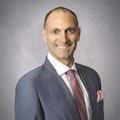
Scott Froum, DDS
Editorial Director
Scott Froum, DDS, a graduate of the State University of New York, Stony Brook School of Dental Medicine, is a periodontist in private practice at 1110 2nd Avenue, Suite 305, New York City, New York. He is the editorial director of Perio-Implant Advisory and serves on the editorial advisory board of Dental Economics. Dr. Froum, a diplomate of both the American Academy of Periodontology and the American Academy of Osseointegration, is a volunteer professor in the postgraduate periodontal program at SUNY Stony Brook School of Dental Medicine. He is a PhD candidate in the field of functional and integrative nutrition. Contact him through his website at drscottfroum.com or (212) 751-8530.
